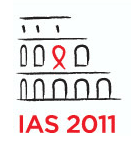 Just as people coinfected with HIV and hepatitis B virus (HBV) dually benefit from taking the antiretroviral Truvada (tenofovir plus emtricitabine), could people coinfected with HIV and hepatitis C virus (HCV) benefit from Selzentry (maraviroc)? Possibly, according to an important new study reported Wednesday, July 20, at the 6th IAS Conference on HIV Pathogenesis, Treatment and Prevention in Rome.
Just as people coinfected with HIV and hepatitis B virus (HBV) dually benefit from taking the antiretroviral Truvada (tenofovir plus emtricitabine), could people coinfected with HIV and hepatitis C virus (HCV) benefit from Selzentry (maraviroc)? Possibly, according to an important new study reported Wednesday, July 20, at the 6th IAS Conference on HIV Pathogenesis, Treatment and Prevention in Rome.
Using noninvasive liver scanning, Paola Nasta, MD, and her colleagues at the University of Brescia in Brescia, Italy, found that the CCR5-blocking activity of Selzentry appears to minimize liver stiffness in people living with both viruses. Though the implications of this finding aren’t clear, it is potentially good news for coinfected individuals who either cannot take, or are hoping to delay, chronic HCV treatment using today’s side effect–prone regimens.
The study enrolled 54 coinfected people, all of whom were already on an antiretroviral (ARV) regimen for their HIV but hadn’t yet started treatment for their HCV. Twenty-eight study volunteers added Selzentry to their ARV regimen, consisting of Norvir (ritonavir)–boosted Reyataz plus Truvada. The remaining participants served as a control group.
Volunteers were, on average, 46 years old. Most were men with CD4 counts averaging 500 cells. More than 90 percent of those enrolled had hard-to-treat HCV genotypes 1 or 4.
All participants underwent FibroScan testing, an ultrasound-based measure of liver stiffness, upon entering the study and six months later. Though FibroScan results can be roughly translated into the universal standard of fibrosis staging—METAVIR scoring based on the liver biopsy results—there is some controversy regarding the sensitivity of the test. It appears most effective at detecting advanced fibrosis (cirrhosis) and is less sensitive in detecting mild or moderate fibrosis.
Across the board, FibroScan-translated METAVIR scores, which range from “F0” (no fibrosis) to “F4” (cirrhosis), neither improved nor worsened in the majority of people in both groups, with more in the Selzentry group holding steady. Where changes in fibrosis scores were noted, they were more likely to be improvements among those taking Selzentry and worsening liver stiffness among those in the control group.
Among those who didn’t add Selzentry and had evidence of a change in liver stiffness, there was a drop in the number of people with a score of F1 (57 to 47 percent), and their liver stiffness moved on to a score of F2 or higher. Conversely, there was an increased number of participants with a score of F1 in the Selzentry group (35 to 44 percent), reflecting a reduced number of participants with more advanced fibrosis scores upon starting the study.
Nasta noted that HCV viral loads remained, for the most part, unchanged in the study. The way in which Selzentry potentially worked in her group’s study is unclear, though she noted in her introductory remarks that CCR5—the same protein, or chemokine, that plays a role in HIV entry into cells—among other chemokines may play a role in the way liver scarring occurs, according to studies involving mice.
Curiously, some studies have suggested that the same CCR5 mutation that confers immunity to HIV, or at least slows its disease progression, may actually increase the chances of HCV becoming chronic in people living with the virus. In turn, more research will ultimately be needed to understand the benefits—and potential pitfalls—of using CCR5-targeting ARVs to manage HCV infection and its effects on the liver.






Comments
Comments